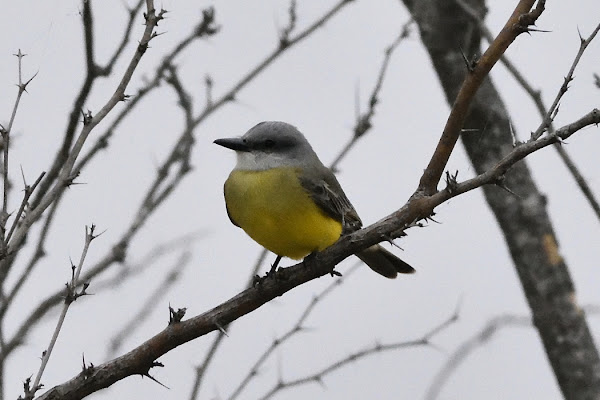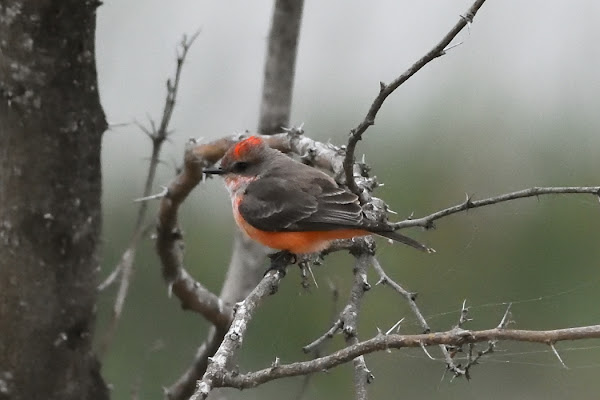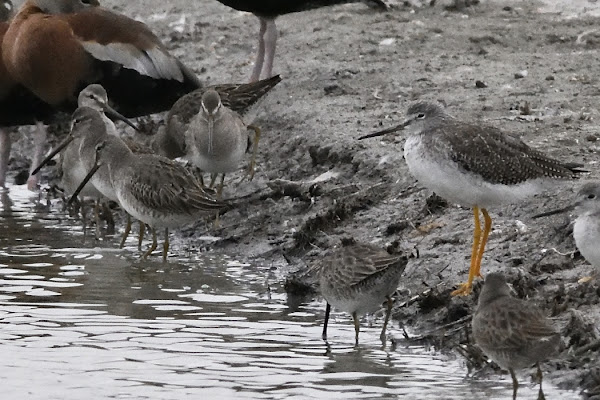I got up early enough to reach Santa Ana National Wildlife Refuge before dawn. I joined the many other birders at the entrance, hoping that the bird would show up this time. It was pretty cold for south Texas. After being in the 80's the day before, a cold front had dropped the temperatures into the 40's and there was a strong wind. I was glad that I had my winter coat with me. At around 7:25, the Bat Falcon was spotted flying over the refuge and then, thankfully, flew in and landed on the pole across from the entrance road. It was still somewhat foggy, so my photos didn't turn out that great, but I was just glad to get to see it.
After about five minutes, it flew east and dove on a passing Red-tailed Hawk. We then watched as it veered around like a large swift, dove on a bird that just missed becoming a meal, and then headed south into the refuge.
I walked into the refuge and scanned all visible snags from the hawk tower to no avail. I continued down the Wildlife Drive (closed to vehicles) to check out the one snag near the Bobcat Trail intersection where the bird had been sporadically appearing during the day. Again, no bird. I then walked the Pintail Lakes Trail to see what was there while having a large open area to watch from. The cold probably had something to do with the lack of landbirds. The walk to the lakes only produced a Great Kiskadee, a few Green Jays, Northern Cardinals, a White-tipped Dove, a Lincoln's Sparrow, two Ladder-backed Woodpeckers, a Yellow-bellied Sapsucker, and a Golden-fronted Woodpecker.
An American White Pelican and a Roseate Spoonbill circled the first body of water that also contained Double-crested and Neotropic Cormorant.
The next lake held Pied-billed and Least Grebes, White-faced and White Ibis, a Belted Kingfisher, Northern Shovelers, Northern Pintail, Lesser Scaup, a few Mottled Ducks, a Green-winged Teal, and a couple Cinnamon Teal among the Blue-winged Teal.
Raptors seen in the air included Osprey, Northern Harrier, and Cooper's, Harris's, and Gray Hawk. Two birds that were most likely Tropical Kingbirds were at the corner of the lake. Tropical Kingbirds and Couch's Kingbirds look very similar and when they aren't calling, it can be tough to determine which one is which. The long bill on this bird points to Tropical. An Eastern Phoebe and a young Vermilion Flycatcher were also there.
The third lake produced Black-bellied Whistling-Ducks, Great Blue and Green Heron, Snowy and Great Egrets, Greater Yellowlegs, Long-billed Dowitchers, Least Sandpipers, and Black-necked Stilts.
I left Santa Ana and drove over to Estero Llano Grande State Park. A young Harris's Hawk was on a pole at the parking lot.
A Bronzed Cowbird visited the feeder with the Red-winged Blackbirds. There were several hundred Black-bellied Whistling-Ducks throughout the park.
A walk along Alligator Lake produced Anhinga and Yellow-crowned and Black-crowned Night-Herons.
A birder at the visitor center tipped me off to an area to look for Common Pauraque. I found the area that she described yet still had a little trouble spotting the bird. It was like doing a "Where's Waldo" puzzle among the sticks and twigs. It was so surprisingly close to the trail that I had to back up to take its photo.
With some more searching, I eventually found two more birds nearby. After only seeing this species along a road in car headlights years ago, seeing these three in daylight was a real treat. It was definitely one of the highlights of the trip.
There were Least Grebes and White Ibis in Dowitcher Pond in addition to the many Black-bellied Whistling-Ducks. Other birds found here that weren't seen at Santa Ana included Gadwall, Common Gallinule, and American Coot.
I returned to Santa Ana to see if the Bat Falcon would perch on the pole before going to roost. At 5:40, it did just that. Unfortunately, the failing light made getting good photos difficult once again.
Soon after, it headed for its palm tree roost west of the refuge entrance.
I returned to Pharr and spent my second night at the LaQuinta Inn.






























No comments:
Post a Comment